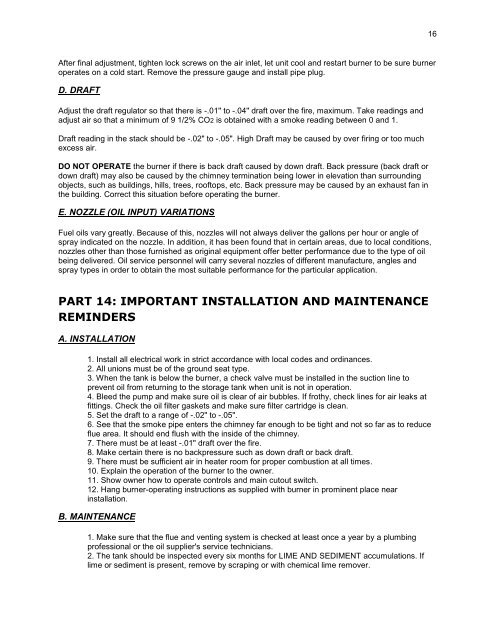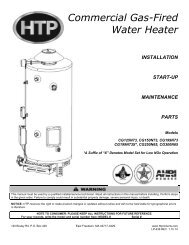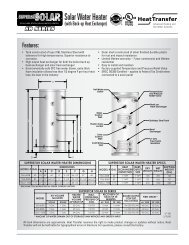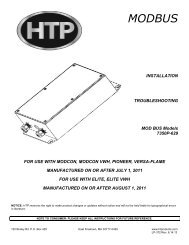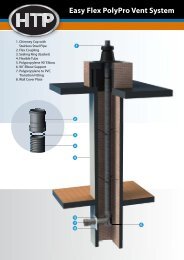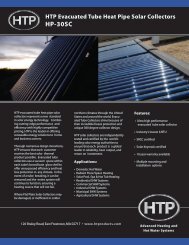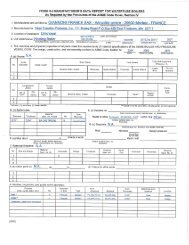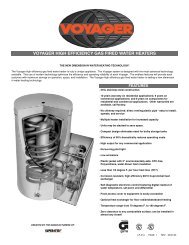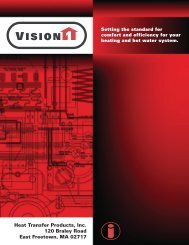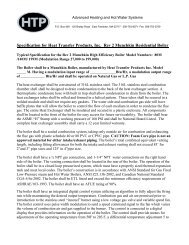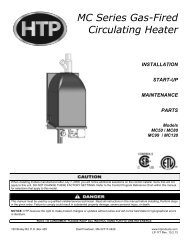SuperStor Oil Fired Water Heater
SuperStor Oil Fired Water Heater
SuperStor Oil Fired Water Heater
You also want an ePaper? Increase the reach of your titles
YUMPU automatically turns print PDFs into web optimized ePapers that Google loves.
16<br />
After final adjustment, tighten lock screws on the air inlet, let unit cool and restart burner to be sure burner<br />
operates on a cold start. Remove the pressure gauge and install pipe plug.<br />
D. DRAFT<br />
Adjust the draft regulator so that there is -.01" to -.04" draft over the fire, maximum. Take readings and<br />
adjust air so that a minimum of 9 1/2% CO2 is obtained with a smoke reading between 0 and 1.<br />
Draft reading in the stack should be -.02" to -.05". High Draft may be caused by over firing or too much<br />
excess air.<br />
DO NOT OPERATE the burner if there is back draft caused by down draft. Back pressure (back draft or<br />
down draft) may also be caused by the chimney termination being lower in elevation than surrounding<br />
objects, such as buildings, hills, trees, rooftops, etc. Back pressure may be caused by an exhaust fan in<br />
the building. Correct this situation before operating the burner.<br />
E. NOZZLE (OIL INPUT) VARIATIONS<br />
Fuel oils vary greatly. Because of this, nozzles will not always deliver the gallons per hour or angle of<br />
spray indicated on the nozzle. In addition, it has been found that in certain areas, due to local conditions,<br />
nozzles other than those furnished as original equipment offer better performance due to the type of oil<br />
being delivered. <strong>Oil</strong> service personnel will carry several nozzles of different manufacture, angles and<br />
spray types in order to obtain the most suitable performance for the particular application.<br />
PART 14: IMPORTANT INSTALLATION AND MAINTENANCE<br />
REMINDERS<br />
A. INSTALLATION<br />
1. Install all electrical work in strict accordance with local codes and ordinances.<br />
2. All unions must be of the ground seat type.<br />
3. When the tank is below the burner, a check valve must be installed in the suction line to<br />
prevent oil from returning to the storage tank when unit is not in operation.<br />
4. Bleed the pump and make sure oil is clear of air bubbles. If frothy, check lines for air leaks at<br />
fittings. Check the oil filter gaskets and make sure filter cartridge is clean.<br />
5. Set the draft to a range of -.02" to -.05".<br />
6. See that the smoke pipe enters the chimney far enough to be tight and not so far as to reduce<br />
flue area. It should end flush with the inside of the chimney.<br />
7. There must be at least -.01" draft over the fire.<br />
8. Make certain there is no backpressure such as down draft or back draft.<br />
9. There must be sufficient air in heater room for proper combustion at all times.<br />
10. Explain the operation of the burner to the owner.<br />
11. Show owner how to operate controls and main cutout switch.<br />
12. Hang burner-operating instructions as supplied with burner in prominent place near<br />
installation.<br />
B. MAINTENANCE<br />
1. Make sure that the flue and venting system is checked at least once a year by a plumbing<br />
professional or the oil supplier's service technicians.<br />
2. The tank should be inspected every six months for LIME AND SEDIMENT accumulations. If<br />
lime or sediment is present, remove by scraping or with chemical lime remover.


